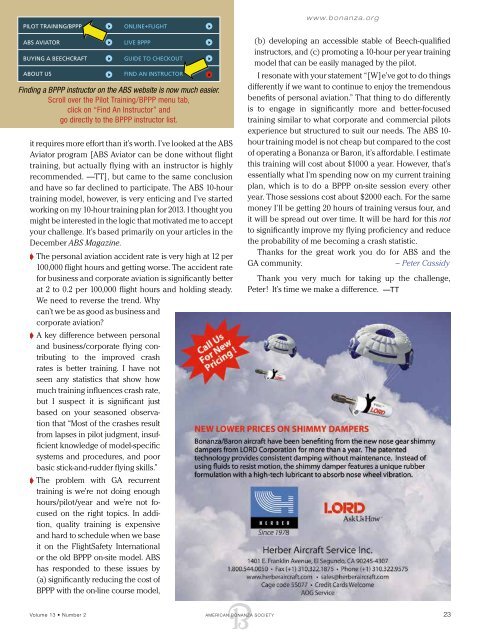ABS Fly-In Savannah, Georgia, May 16-19 See Page 3 - American ...
ABS Fly-In Savannah, Georgia, May 16-19 See Page 3 - American ...
ABS Fly-In Savannah, Georgia, May 16-19 See Page 3 - American ...
You also want an ePaper? Increase the reach of your titles
YUMPU automatically turns print PDFs into web optimized ePapers that Google loves.
PILOT TRAINING/BPPPonline+FLIGHTwww.bonanza.org<strong>ABS</strong> AVIATORBUYING A BEECHCRAFTABOUT USlive bpppguide to checkoutfind an instructorFinding a BPPP instructor on the <strong>ABS</strong> website is now much easier.Scroll over the Pilot Training/BPPP menu tab,click on “Find An <strong>In</strong>structor” andgo directly to the BPPP instructor list.it requires more effort than it’s worth. I’ve looked at the <strong>ABS</strong>Aviator program [<strong>ABS</strong> Aviator can be done without flighttraining, but actually flying with an instructor is highlyrecommended. —TT], but came to the same conclusionand have so far declined to participate. The <strong>ABS</strong> 10-hourtraining model, however, is very enticing and I’ve startedworking on my 10-hour training plan for 2013. I thought youmight be interested in the logic that motivated me to acceptyour challenge. It’s based primarily on your articles in theDecember <strong>ABS</strong> Magazine. The personal aviation accident rate is very high at 12 per100,000 flight hours and getting worse. The accident ratefor business and corporate aviation is significantly betterat 2 to 0.2 per 100,000 flight hours and holding steady.We need to reverse the trend. Whycan’t we be as good as business andcorporate aviation? A key difference between personaland business/corporate flying contributingto the improved crashrates is better training. I have notseen any statistics that show howmuch training influences crash rate,but I suspect it is significant justbased on your seasoned observationthat “Most of the crashes resultfrom lapses in pilot judgment, insufficientknowledge of model-specificsystems and procedures, and poorbasic stick-and-rudder flying skills.” The problem with GA recurrenttraining is we’re not doing enoughhours/pilot/year and we’re not focusedon the right topics. <strong>In</strong> addition,quality training is expensiveand hard to schedule when we baseit on the FlightSafety <strong>In</strong>ternationalor the old BPPP on-site model. <strong>ABS</strong>has responded to these issues by(a) significantly reducing the cost ofBPPP with the on-line course model,(b) developing an accessible stable of Beech-qualifiedinstructors, and (c) promoting a 10-hour per year trainingmodel that can be easily managed by the pilot.I resonate with your statement “[W]e’ve got to do thingsdifferently if we want to continue to enjoy the tremendousbenefits of personal aviation.” That thing to do differentlyis to engage in significantly more and better-focusedtraining similar to what corporate and commercial pilotsexperience but structured to suit our needs. The <strong>ABS</strong> 10-hour training model is not cheap but compared to the costof operating a Bonanza or Baron, it’s affordable. I estimatethis training will cost about $1000 a year. However, that’sessentially what I’m spending now on my current trainingplan, which is to do a BPPP on-site session every otheryear. Those sessions cost about $2000 each. For the samemoney I’ll be getting 20 hours of training versus four, andit will be spread out over time. It will be hard for this notto significantly improve my flying proficiency and reducethe probability of me becoming a crash statistic.Thanks for the great work you do for <strong>ABS</strong> and theGA community.– Peter CassidyThank you very much for taking up the challenge,Peter! It’s time we make a difference. —TTVolume 13 • Number 2 AMERICAN BONANZA SOCIETY 23

















